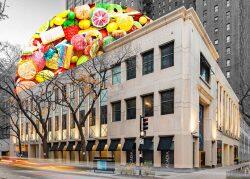Magnificence could soon be on the agendas of beachgoers before or after they head to the Chicago lakefront.
A new pedestrian bridge connecting the city’s Oak Street Beach and its most famous shopping district, the Magnificent Mile, could bring more allure back to the corridor damaged badly by the rise of e-commerce and COVID-19, according to a new report from the Urban Land Institute, reported earlier by Crain’s.
Mag Mile’s retail vacancy rate is about 25 percent, up from 12 percent in 2018, Chicago-based Cushman & Wakefield found, and an investor in the North Bridge Mall took a big loss on a sale of its stake last month.
One of the Urban Land Institute’s main takeaways is that the Mag Mile has a large concentration of brand-name stores found in many other malls across the country, and that it could benefit by offering more experiences other than shopping highly recognizable retailers.
Easing entry to the beach from the Mag Mile by building a crossing over Lake Shore Drive would be a part of an effort to activate the strip beyond the traditional retail model.
“Accessing it from the Mag Mile is not necessarily a world class experience today,” Scott Hurst, a member of the Urban Land Institute panel who is a designer with architecture firm Gensler, said.
Replicating some of the retail strategies that have yielded success just around the corner from Michigan Avenue on Oak Street, at the Mag Mile’s north end, is also among the panel’s recommendations, suggesting that boutique-type stores and brands unique to Chicago could become tenants beside small-scale luxury stores between the Drake Hotel and 875 North Michigan Avenue, formerly called the John Hancock Center.
Recent sales prices give reason to build on the Oak Street momentum. In November, a New York investment firm sold an East Oak property for $4,165 per square foot, the third most ever paid for a retail property in the city, at $120 million total, The Real Deal reported.
“East Oak Street is the number one destination for luxury goods and fashion,” Kseniya Merritt, head of North America’s retail investments in Union Investment, said at the time. “Due to the demand for space, vacancies are historically low and rents are stable.”
Some of the work to bring attractions that draw visitors outside the traditional shopping crowds and to downsize retail spaces has already begun. The institute pointed to the Dr. Seuss gallery in Water Tower Place as a strong lure that could be built upon.
Getting all Mag Mile landlords on board with the ideas outlined in the Urban Land Institute report will face challenges, warned Max Meyer of R2 Companies, a member of a December panel hosted by the institute and the city. Leasing to stores that complement rather than compete with one another isn’t always possible.
“Co-tenancy has really suffered. Juxtaposed with that, you have disparate owners with different financial conditions and it’s very hard to get kind of a cohesive approach to what tenancy should look like,” Meyer said.
The report steered the city toward giving reductions in real estate tax assessments that could be passed onto tenants as reduced rents to help make it easier for small, local businesses to locate on Michigan Avenue.
There will still be a place for bigger retailers and luxury brands to have flagship stores, if the new suggestions for the Mag Mile’s north end pan out. The panel believes large retail spaces between Chicago and Grand Avenues, where much is already offered as some of the section is struggling, can continue to have appeal as a cluster in the middle of the mile.
Officials and property owners will also need to confront a rising tide of crime committed during the pandemic in places visible from sidewalks and storefronts in Chicago, including on the Mag Mile and the greater Streeterville neighborhood, for the shopping district to bounce back, The Real Deal reported.
One of the suggestions is funds from a special district tax the City Council agreed to pass for the Magnificent Mile area that took effect this year could go toward implementing more security measures, including heightened police presence and additional technology for surveillance, quick crime reporting and prevention.
[Crain’s] – Sam Lounsberry
Read more

